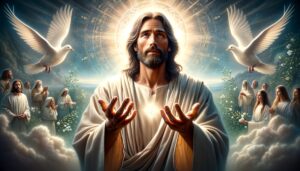Gospel of Matthew Chapters 19-24 Overview

The Values and Ethics of the Kingdom of God, Including Humility, Faithfulness, Servanthood, and Love
Gospel of Matthew Chapters 19-24 Overview. These chapters highlight the values and ethics of the Kingdom of God, including humility, faithfulness, servanthood, and love.
Jesus’ actions and teachings affirm His identity as the Messiah, fulfilling prophecies and revealing His divine authority. He teaches about the end times and His second coming, all while provide hope and a forward-looking expectation for believers, encouraging them to remain vigilant and faithful.
Gospel of Matthew Chapters 19-24 Overview

Teaching about Divorce (Matthew 19:1-12)
Jesus addresses the issue of divorce, stating that marriage is a lifelong commitment and that divorce should only occur in the case of sexual immorality. He emphasizes the sanctity and permanence of marriage, advocating for faithfulness and highlighting the seriousness of divorce.
Blessing the Children (Matthew 19:13-15)
Jesus welcomes and blesses little children, emphasizing the importance of childlike faith. He underscores the value of childlike humility and openness as essential for entering the Kingdom of Heaven.
Wealth and Discipleship (Matthew 19:16-30)
A rich young man asks Jesus about eternal life. Jesus tells him to keep the commandments and to sell his possessions and give to the poor. The man leaves sorrowfully, and Jesus teaches about the difficulty for the rich to enter the kingdom of heaven. This encounter with the rich young ruler illustrates the challenges of wealth in relation to following Jesus and entering the Kingdom of God. Jesus calls for radical commitment and prioritization of spiritual over material wealth.

Parable of the Workers in the Vineyard (Matthew 20:1-16)
Jesus tells a parable about a landowner who hires workers at different times of the day but pays them all the same wage, illustrating God’s generosity and the last being first.
Jesus Predicts His Death a Third Time (Matthew 20:17-19)
Jesus again foretells His suffering, death, and resurrection.
A Mother’s Request (Matthew 20:20-28)
The mother of James and John asks Jesus for her sons to sit at His right and left in His kingdom. Jesus teaches that greatness in His Kingdom is measured by servanthood and humility, contrasting with worldly views of power and authority.
Healing Two Blind Men (Matthew 20:29-34)
Jesus heals two blind men who call out to Him as He leaves Jericho. His healing of the blind men exemplifies His compassion and power, reinforcing His identity as the Messiah.

The Triumphal Entry (Matthew 21:1-11)
Jesus enters Jerusalem riding on a donkey, fulfilling prophecy and being hailed as the Messiah.
Cleansing the Temple (Matthew 21:12-17)
Jesus drives out the money changers and merchants from the temple, declaring it a house of prayer.
The Fig Tree Withers (Matthew 21:18-21)
Jesus curses a barren fig tree, which withers, symbolizing the judgment on unfruitful Israel.
* The cleansing of the temple and the cursing of the fig tree symbolize judgment on unfaithfulness and religious hypocrisy.
Questioning of Jesus’ Authority (Matthew 21:23-27)
Religious leaders challenge Jesus’ authority, and He responds with a question about John the Baptist. Through parables and interactions, Jesus challenges the religious leaders’ authority and exposes their rejection of God’s messengers, including Himself.
Parable of the Two Sons (Matthew 21:28-32)
Jesus tells a parable about two sons, one who initially disobeys but then obeys, and one who says he will obey but does not, highlighting repentance and obedience.
Parable of the Tenants (Matthew 21:33-46)
Jesus tells a parable about wicked tenants who kill the landowner’s son, representing the rejection of Jesus by the religious leaders.

Parable of the Wedding Banquet (Matthew 22:1-14)
Jesus tells a parable about a king who invites guests to his son’s wedding banquet, but many refuse. The king then invites others, illustrating the inclusivity of the kingdom of God.
Paying Taxes to Caesar (Matthew 22:15-22)
The Pharisees try to trap Jesus with a question about paying taxes to Caesar. Jesus responds by saying to give to Caesar what is Caesar’s and to God what is God’s.
Marriage at the Resurrection (Matthew:22:23-33)
The Sadducees question Jesus about marriage in the resurrection, and He teaches about the nature of eternal life.
The Greatest Commandment (Matthew 22:34-40)
Jesus distills the law into the greatest commandments of loving God and loving one’s neighbor, emphasizing the core of His ethical teachings.
Whose Son is the Messiah? (Matthew 22:41-46)
Jesus questions the Pharisees about the nature of the Messiah, revealing His divine sonship and challenging their understanding.

Seven Woes on the Teachers of the Law and the Pharisees (Matthew 23:1-36)
Jesus delivers a scathing critique of the scribes and Pharisees for their hypocrisy, legalism, and neglect of justice, mercy, and faithfulness. and pronounces a series of woes against them. The woes pronounced on the religious leaders serve as a call to genuine faith and integrity, warning against outward religiosity without inward transformation.
Lament Over Jerusalem (Matthew 23:37-39)
Jesus laments over Jerusalem’s history of rejecting prophets and expresses sorrow for the city’s impending judgment.

Prediction of the Temple’s Destruction (Matthew 24:1-2)
Jesus predicts the destruction of the Jerusalem Temple.
Signs of the End Times (Matthew 24:3-14)
Jesus describes the signs of the end times, including false messiahs, wars, famines, and earthquakes.
The Great Tribulation (Matthew 24: 15-28)
Jesus speaks of a time of great distress and persecution.
The Coming of the Son of Man (Matthew 24:29-31)
Jesus describes His second coming with cosmic signs and the gathering of the elect.
The Lesson of the Fig Tree (Matthew 24:32-35)
Jesus uses the fig tree as an illustration of recognizing the signs of the times.
The Unknown Day and Hour (Matthew 24:36-51)
The emphasis on the unknown day and hour of Jesus’ return highlights the need for constant vigilance and readiness, faithfulness, and watchfulness among His followers.
You must be logged in to post a comment.